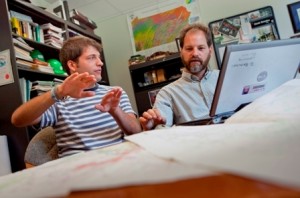
Alec Bernstein '11 (left) works on a project with David Brandes, associate professor of civil and environmental engineering.
As energy-producing wind turbines rise in ever greater numbers throughout the world, scientists have become increasingly concerned with their effects on migrating bats and birds—including the majestic golden eagle and other raptors.
David Brandes, associate professor of civil and environmental engineering, is working with an interdisciplinary group that is using a global positioning system (GPS) and cell phone technology to track golden eagles as they migrate between Quebec and southern Appalachia, many of them traveling through Pennsylvania on the Kittatinny Ridge and other parallel ridges and mountains to the west.
The team includes researchers from West Virginia University in Morgantown, W.Va.; the Carnegie Museum of Natural History, both in Pittsburgh, Pa.; the Powdermill Avian Research Center in Westmoreland County, Pa.; and Hawk Mountain Sanctuary in Kempton, Pa. The project is currently funded by a U.S. Department of Energy grant and previously received two Pennsylvania Game Commission State Wildlife grants and a grant from the Pennsylvania Department of Conservation of Natural Resources.
“What we’re most interested in is figuring out how these birds navigate through the whole mountain range,” Brandes says. “Where do they prefer to fly?”
He says that solar-powered satellite tracking units, attached backpack style to eagles, give the group hourly data on where the birds have flown. Newer cell phone-based units give minute-by-minute data, but do not transmit when the birds fly to the far north, out of cell phone-tower range.
“My main role on the team is in the development of mathematical models of migration pathways,” he says. “I’m looking at the terrain, as well as wind conditions, and I’m able to predict flight paths based on the energy minimization concept.”
Brandes says data has shown that the eagles are often flying at the same altitudes as modern wind turbines, but the cell-phone tracking information will provide a much clearer picture.
“We will actually be able to see how birds react to turbines,” he says. “We think they can co-exist, but the turbines can’t be put up willy nilly.”
Brandes collaborate with Spanish scientists studying raptor migration near the Strait of Gibraltar this spring as he teaches in Lafayette’s semester-abroad program in Spain.
Besides raptor migration, Brandes’ main area of research is in hydrology and hydraulics. He often includes students in his research through the EXCEL Scholars program, honors theses, and independent projects. He has published dozens of articles in scholarly journals and presented his work at national and international conferences. This summer, he worked with civil engineering major Alec Bernstein ’11 (Colts Neck, N.J.), investigating the flooding susceptibility of watersheds based on characteristics such as geomorphology, rainfall, land cover, and geology.
